Response of Matching Degree between Precipitation and Maize Water Requirement to Climate Change in China
Abstract
:1. Introduction
2. Materials and Methods
2.1. Study Area
2.2. Historical and Future Climate Data
2.3. Bias Correction of Future Climate Data
2.4. AquaCrop Model and Input Data
2.5. Effective Precipitation, Crop Water Requirement, and MDPCWR
3. Results
3.1. AquaCrop Performance in Simulating Maize Phenology
3.2. The Performance of CDF-t
3.3. Spatial–Temporal Changes in Climate under Two Future Scenarios
3.4. Impacts of Climate Change on Maize FC, WR, and IWR
3.5. Impacts of Climate Change on the MDPCWR
4. Discussion
5. Conclusions
Author Contributions
Funding
Data Availability Statement
Acknowledgments
Conflicts of Interest
Abbreviations
| MDPCWR | Matching degree between precipitation and crop water requirement |
| CDF-t | Cumulative distribution function-transform |
| CMIP6 | Phase six of the Coupled Model Intercomparison Project |
| GCMs | Global Climate models |
| 3H | Huang–Huai–Hai |
| CMA | China Meteorological Administration |
| Tx | Maximum temperature |
| Tn | Minimum temperature |
| P | Precipitation |
| Pe | Effective precipitation |
| KDD | killing degree days, accumulated temperature higher than 35 °C |
| ETp | Actual evapotranspiration |
| ETa | Potential evapotranspiration |
| ETo | Reference evapotranspiration |
| FC | Crop fertility cycle |
| WR | Crop water requirement |
| IWR | Crop irrigation water requirement |
References
- Yang, S.; Ding, Z.; Li, Y.; Wang, X.; Jiang, W.; Huang, X. Warming-induced northwestward migration of the East Asian monsoon rain belt from the Last Glacial Maximum to the mid-Holocene. Proc. Natl. Acad. Sci. USA 2015, 112, 13178–13183. [Google Scholar] [CrossRef] [PubMed]
- He, J.; Ju, J.; Wen, Z.; Lu, J.; Jin, Q. A Review of Recent Advances in Research on Asian Monsoon in China. Adv. Atmos. Sci. 2007, 24, 972–992. [Google Scholar] [CrossRef]
- Zhang, Q.; Wang, Y. Distribution of hazard and risk caused by agricultural drought and flood and their correlations in summer monsoon–affected areas of China. Theor. Appl. Climatol. 2022, 149, 965–981. [Google Scholar] [CrossRef]
- Chen, X.; Wang, L.; Niu, Z. The effects of projected climate change and extreme climate on maize and rice in the Yangtze River Basin, China. Agric. For. Meteorol. 2020, 282–283, 107867. [Google Scholar] [CrossRef]
- IPCC. Climate Change 2022: Impacts, Adaptation, and Vulnerability. In Contribution of Working Group II to the Sixth Assessment Report of the Intergovernmental Panel on Climate Change; Pörtner, H.-O., Roberts, D.C., Tignor, M., Poloczanska, E.S., Mintenbeck, K., Alegría, A., Craig, M., Langsdorf, S., Löschke, S., Möller, V., et al., Eds.; Cambridge University Press: Cambridge, UK; New York, NY, USA, 2022; 3056p. [Google Scholar]
- Chen, F.; Chen, J.; Huang, W.; Chen, S.; Huang, X.; Jin, L.; Jia, J.; Zhang, X.; An, C.; Zhang, J.; et al. Westerlies Asia and monsoonal Asia: Spatiotemporal differences in climate change and possible mechanisms on decadal to sub-orbital timescales. Earth-Sci. Rev. 2019, 192, 337–354. [Google Scholar] [CrossRef]
- Zhang, Q.; Sun, P.; Singh, V.P.; Chen, X. Spatial-temporal precipitation changes (1956–2000) and their implications for agriculture in China. Glob. Planet. Chang. 2012, 82, 86–95. [Google Scholar] [CrossRef]
- Tian, J.; Zhang, Z.; Ahmed, Z.; Zhang, L.; Su, B.; Tao, H.; Jiang, T. Projections of precipitation over China based on CMIP6 models. Stoch. Environ. Res. Risk Assess. 2021, 35, 831–848. [Google Scholar] [CrossRef]
- Ding, Y.; Wan, W.; Song, R.; Shao, Q.; Jiao, X.; Xing, W. Modeling spatial and temporal variability of the impact of climate change on rice irrigation water requirements in the middle and lower reaches of the Yangtze River, China. Agric. Water Manag. 2017, 193, 89–101. [Google Scholar] [CrossRef]
- Ding, Y.; Wang, W.; Zhuang, Q.; Luo, Y. Adaptation of paddy rice in China to climate change: The effects of shifting sowing date on yield and irrigation water requirement. Agric. Water Manag. 2020, 228, 105890. [Google Scholar] [CrossRef]
- Wang, W.; Ding, Y.; Shao, Q.; Xu, J.; Jiao, X.; Luo, Y.; Yu, Z. Bayesian multi-model projection of irrigation requirement and water use efficiency in three typical rice plantation region of China based on CMIP5. Agric. For. Meteorol. 2017, 232, 89–105. [Google Scholar] [CrossRef]
- Zhang, F.; Chi, D.; Chen, T. Assessment of Coupling Degree between Water Requirement of Main Cereal Crops and Precipitation in Growing Season in Liaoning Province. China J. Agrometeorol. 2021, 42, 746–760. [Google Scholar]
- Tao, F.; Zhang, Z.; Shi, W.; Liu, Y.; Xiao, D.; Zhang, S.; Zhu, Z.; Wang, M.; Liu, F. Single rice growth period was prolonged by cultivars shifts, but yield was damaged by climate change during 1981–2009 in China, and late rice was just opposite. Glob. Chang. Biol. 2013, 19, 3200–3209. [Google Scholar] [CrossRef] [PubMed]
- White, J.; Hoogenboom, G.; Kimball, B.; Wall, G. Methodologies for simulating impacts of climate change on crop production. Field Crop. Res. 2011, 124, 357–368. [Google Scholar] [CrossRef]
- Sultan, B.; Defrance, D.; Iizumi, T. Evidence of crop production losses in West Africa due to historical global warming in two crop models. Sci. Rep. 2019, 9, 12834. [Google Scholar] [CrossRef] [PubMed]
- Rocha, J.; Carvalho-Santos, C.; Diogo, P.; Beca, P.; Keizer, J.; Nunes, J. Impacts of climate change on reservoir water availability, quality and irrigation needs in a water scarce Mediterranean region (southern Portugal). Sci. Total Environ. 2020, 736, 139477. [Google Scholar] [CrossRef] [PubMed]
- Stenzel, F.; Greve, P.; Lucht, W.; Tramberend, S.; Wada, Y.; Gerten, D. Irrigation of biomass plantations may globally increase water stress more than climate change. Nat. Commun. 2021, 12, 1512. [Google Scholar] [CrossRef] [PubMed]
- Luo, W.; Chen, M.; Kang, Y.; Li, D.; Cui, Y.; Khan, S.; Luo, Y. Analysis of crop water requirements and irrigation demands for rice: Implications for increasing effective rainfall. Agric. Water Manag. 2022, 260, 107285. [Google Scholar] [CrossRef]
- Lu, J.; Zhu, W.; Gao, Z. Analysis of coupling degree between water demand of main crops and rainfall in Loess Hilly region of Northern Shaanxi. Water Sav. Irrig. 2019, 12, 72–76. [Google Scholar]
- Zhang, Q.; Dong, W.; Wen, C. Study on factors affecting corn yield based on the Cobb-Douglas production function. Agric. Water Manag. 2019, 228, 105869. [Google Scholar] [CrossRef]
- Allen, R.; Pereira, L.; Raes, D.; Smith, M. Crop Evapotranspiration Guidelines for Computing Crop Water Requirements-Irrigation and Drainage Paper 56; Food and Agriculture Organization of the United Station: Rome, Italy, 1998. [Google Scholar]
- Paredes, P.; Pereira, L.; Almorox, J.; Darouich, H. Reference grass evapotranspiration with reduced data sets: Parameterization of the FAO Penman-Monteith temperature approach and the Hargeaves-Samani equation using local climatic variables. Agric. Water Manag. 2020, 240, 106210. [Google Scholar] [CrossRef]
- Zhang, Z.; Hao, W.; Li, H.; Mao, L.; Xiang, G. Analysis on the Drought Characteristics in Different Growth Stages of Spring Maize in Shanxi Province. China J. Agrometeorol. 2015, 36, 754–761. [Google Scholar]
- Panda, R.; Behera, S.; Kashyap, P. Effective management of irrigation water for maize under stressed conditions. Agric. Water Manag. 2004, 66, 181–203. [Google Scholar] [CrossRef]
- Song, X.; Zhou, G.; He, Q.; Zhou, H. Stomatal limitations to photosynthesis and their critical Water conditions in different growth stages of maize under water stress. Agric. Water Manag. 2020, 241, 106330. [Google Scholar] [CrossRef]
- Brejda, J.; Moorman, T.; Smith, J.; Karlen, D.; Allan, D.; Dao, T. Distribution and Variability of Surface Soil Properties at a Regional Scale. Soil Sci. Soc. Am. J. 2000, 64, 974–982. [Google Scholar] [CrossRef]
- Koutnik, V.; Leonard, J.; Alkidim, S.; Deprima, F.; Ravi, S.; Hoek, E.; Mohanty, S. Distribution of microplastics in soil and freshwater environments: Global analysis and framework for transport modeling. Environ. Pollut. 2021, 274, 116552. [Google Scholar] [CrossRef]
- Asseng, S.; Keulen, H.; Stol, W. Performance and application of the APSIM Nwheat model in the Netherlands. Eur. J. Agron. 2000, 12, 37–54. [Google Scholar] [CrossRef]
- de Wit, A.; Boogaard, H.; Fumagalli, D.; Janssen, S.; Knapen, R.; Kraalingen, D.; Supit, I.; Wijngaart, R.; Diepen, K. 25 years of the WOFOST cropping systems model. Agric. Syst. 2018, 168, S0308521X17310107. [Google Scholar] [CrossRef]
- Li, T.; Angeles, O.; Marcaida, M.; Manalo, E.; Manalili, M.; Radanielson, A.; Mohanty, S. From ORYZA2000 to ORYZA (v3): An improved simulation model for rice in drought and nitrogen-deficient environments. Agric. For. Meteorol. 2017, 237–238, 246–256. [Google Scholar] [CrossRef]
- Yu, Q.; Cui, Y.; Han, H.; Liao, B. Modelling water consumption and nitrogen loss in paddy fields with an improved ORYZA model. Field Crop. Res. 2023, 292, 108828. [Google Scholar] [CrossRef]
- Vanuytrecht, E.; Raes, D.; Steduto, P.; Hsiao, T.; Fereres, E.; Heng, L.; Vila, M.; Moreno, P. AquaCrop: FAO’s crop water productivity and yield response model. Environ. Model. Softw. 2014, 62, 351–360. [Google Scholar] [CrossRef]
- Jones, J.; Hoogenboom, G.; Poter, C.; Boote, K.; Batchelor, W.; Hunt, L.; Wilkens, P.; Singh, U.; Gijsman, A.; Ritchie, J. The DSSAT cropping system model. Eur. J. Agron. 2003, 18, 235–265. [Google Scholar] [CrossRef]
- Foster, T.; Brozovi, N.; Butler, A.; Neale, C.; Raes, D.; Steduto, P.; Fereres, E.; Hsiao, T. AquaCrop-OS: An open source version of FAO's crop water productivity model. Agric. Water Manag. 2017, 181, 18–22. [Google Scholar] [CrossRef]
- Umesh, B.; Reddy, K.; Polisgowdar, B.; Maruthi, V.; Satishkumar, U.; Ayyanagoudar, M.; Rao, S.; Veeresh, H. Assessment of climate change impact on maize (Zea mays L.) through aquacrop model in semi-arid alfisol of southern Telangana. Agric. Water Manag. 2022, 274, 107950. [Google Scholar] [CrossRef]
- Zhang, C.; Xie, Z.; Wang, Q.; Tang, M.; Feng, S.; Cai, H. AquaCrop modeling to explore optimal irrigation of winter wheat for improving grain yield and water productivity. Agric. Water Manag. 2022, 266, 107580. [Google Scholar] [CrossRef]
- Raes, D.; Fereres, E.; Curnel, Y.; Vlia, M.; Knoded, D.; Celik, S.; Ucar, Y.; Turk, M.; Wellens, J. Simulation of alfalfa yield with AquaCrop. Agric. Water Manag. 2023, 284, 108341. [Google Scholar] [CrossRef]
- Xiao, D.; Liu, D.; Wang, B.; Feng, P.; Bai, H.; Tang, J. Climate change impact on yields and water use of wheat and maize in the North China Plain under future climate change scenarios. Agric. Water Manag. 2020, 238, 106238. [Google Scholar] [CrossRef]
- Ahmadi, M.; Etedali, H.; Elbeltagi, A. Evaluation of the effect of climate change on maize water footprint under RCPs scenarios in Qazvin plain, Iran. Agric. Water Manag. 2021, 254, 106969. [Google Scholar] [CrossRef]
- Falconnier, G.; Corbeels, M.; Boote, K.; Affholder, F.; Adam, M.; MacCarthy, D.; Ruane, A.; Nendel, C.; Whitbread, A.; Justes, E.; et al. Modelling climate change impacts on maize yields under low nitrogen input conditions in sub-Saharan Africa. Glob. Chang. Biol. 2020, 26, 5942–5964. [Google Scholar] [CrossRef]
- Chen, Z.; Zhou, T.; Zhang, L.; Chen, X.; Zhang, W.; Jiang, J. Global land monsoon precipitation changes in CMIP6 projection. Geophys. Res. Lett. 2020, 47, e2019GL086902. [Google Scholar] [CrossRef]
- Zelinka, M.; Myers, T.; Mccoy, D.; Po-Chedley, S.; Caldwell, P.; Ceppi, P.; Klein, S.; Taylor, K. Causes of Higher Climate Sensitivity in CMIP6 Models. Geophys. Res. Lett. 2020, 47, e2019GL085782. [Google Scholar] [CrossRef]
- Tokarska, K.; Stolpe, M.; Sippel, S.; Fischer, E.; Smith, C.; Lehner, F.; Knutti, R. Past warming trend constrains future warming in CMIP6 models. Sci. Adv. 2020, 6, 2375–2548. [Google Scholar] [CrossRef] [PubMed]
- Meehl, G.; Senior, C.; Eyring, V.; Flato, G.; Lamarque, J.; Stouffer, R.; Taylor, K.; Schlund, M. Context for interpreting equilibrium climate sensitivity and transient climate response from the CMIP6 Earth system models. Sci. Adv. 2020, 6, eaba1981. [Google Scholar] [CrossRef] [PubMed]
- Niu, J.; Qin, W.; Wang, L.; Zhang, M.; Wu, J.; Zhang, Y. Climate change impact on photovoltaic power potential in China based on CMIP6 models. Sci. Total Environ. 2023, 858, 159776. [Google Scholar] [CrossRef]
- Zhu, H.; Jiang, Z.; Juan, L.; Li, W.; Sun, C.; Li, L. Does CMIP6 Inspire More Confidence in Simulating Climate Extremes over China? Adv. Atmos. Sci. 2020, 37, 1119–1132. [Google Scholar] [CrossRef]
- Kim, Y.; Min, S.; Zhang, X.; Sillmann, J.; Sandstad, M. Evaluation of the CMIP6 multi-model ensemble for climate extreme indices. Weather. Clim. Extrem. 2020, 29, 100269. [Google Scholar] [CrossRef]
- Cook, B.; Mankin, J.; Marvel, K.; Williams, A.; Smerdon, J.; Anchukaitis, K. Twenty-first Century Drought Projections in the CMIP6 Forcing Scenarios. Earth's Future 2020, 8, e2019EF001461. [Google Scholar] [CrossRef]
- Wang, T.; Tu, X.; Singh, V.; Chen, X.; Lin, K. Global data assessment and analysis of drought characteristics based on CMIP6. J. Hydrol. 2021, 596, 126091. [Google Scholar] [CrossRef]
- Erenstein, O.; Jaleta, M.; Sonder, K.; Mottaleb, K.; Prasanna, B. Global maize production, consumption and trade: Trends and R&D implications. Food Secur. 2022, 14, 1295–1319. [Google Scholar]
- National Bureau of Statistics of China. China Statistical Yearbook 2021; China Statistics Press: Beijing, China, 2022. [Google Scholar]
- Tao, F.; Zhang, Z. Adaptation of maize production to climate change in North China Plain: Quantify the relative contributions of adaptation options. Eur. J. Agron. 2010, 33, 103–116. [Google Scholar] [CrossRef]
- Yu, Y.; Jiang, Z.; Wang, G.; Kattel, G.; Chuai, X.; Shang, Y.; Zou, Y.; Miao, L. Disintegrating the impact of climate change on maize yield from human management practices in China. Agric. For. Meteorol. 2022, 327, 109235. [Google Scholar] [CrossRef]
- Yan, X.; Chen, X.; Ma, C.; Cai, Y.; Cui, Z.; Chen, X.; Wu, L.; Zhang, F. What are the key factors affecting maize yield response to and agronomic efficiency of phosphorus fertilizer in China? Field Crops Res. 2021, 270, 108221. [Google Scholar] [CrossRef]
- Su, B.; Huang, J.; Mondal, S.; Zhai, J.; Wang, Y.; Wen, S.; Gao, M.; Lv, Y.; Jiang, S.; Jiang, T.; et al. Insight from CMIP6 SSP-RCP scenarios for future drought characteristics in China. Atmos. Res. 2020, 250, 105375. [Google Scholar] [CrossRef]
- Rocheta, E.; Evans, J.; Sharma, A. Assessing atmospheric bias correction for dynamical consistency using potential vorticity. Environ. Res. Lett. 2014, 9, 124010–124016. [Google Scholar] [CrossRef]
- Lavaysse, C.; Vrac, M.; Drobinski, P.; Lengaigne, M.; Vischel, T. Statistical downscaling of the French Mediterranean climate: Assessment for present and projection in an anthropogenic scenario. Nat. Hazards Earth Syst. Sci. 2012, 12, 651–670. [Google Scholar] [CrossRef]
- Lafon, T.; Dadson, S.; Buys, G.; Prudhomme, C. Bias correction of daily precipitation simulated by a regional climate model: A comparison of methods. Int. J. Clim. 2012, 33, 1367–1381. [Google Scholar] [CrossRef]
- Vrac, M.; Drobinski, P.; Merlo, A.; Heremann, M.; Lavaysse, C.; Li, L.; Somot, S. Dynamical and statistical downscaling of the French Mediterranean climate: Uncertainty assessment. Nat. Hazards Earth Syst. Sci. 2012, 12, 2769–2784. [Google Scholar] [CrossRef]
- Milly, P.; Betancourt, J.; Falkenmark, M.; Hirsch, R.; Kundzewicz, Z.; Lettenmaier, D.; Stouffer, R. Stationarity Is Dead: Whither Water Management? Science 2008, 319, 573–574. [Google Scholar] [CrossRef]
- Er-Raki, S.; Bouras, E.; Rodriguez, J.C.; Watts, C.J.; Lizarraga-Celaya, C.; Chehbouni, A. Parameterization of the AquaCrop model for simulating table grapes growth and water productivity in an arid region of Mexico. Agric. Water Manag. 2021, 245, 106585. [Google Scholar] [CrossRef]
- Aziz, M.; Rizvi, S.; Sultan, M.; Bazmi, M.; Shamshiri, R.; Ibrahim, S.; Imran, M. Simulating Cotton Growth and Productivity Using AquaCrop Model under Deficit Irrigation in a Semi-Arid Climate. Agriculture 2022, 12, 242. [Google Scholar] [CrossRef]
- Tang, P.; Li, N.; Li, M.; Zhang, F.; Fu, Q.; Xu, Y.; Liu, D. Rice irrigation water efficiency improvement: An AquaCrop-based optimization modeling approach. Eur. J. Agron. 2023, 148, 126867. [Google Scholar] [CrossRef]
- Shen, S.; Yang, S.; Zhao, Y.; Xu, Y.; Zhao, X.; Wang, Z.; Liu, J.; Zhang, W. Simulating the rice yield change in the middle and lower reaches of the Yangtze River under SRES B2 scenario. Acta Ecol. Sin. 2011, 31, 40–48. [Google Scholar] [CrossRef]
- Liu, X.; Shen, Y. Application of AquaCrop Model for simulating the Summer Maize Water Use in North China Plain. Res. Agric. Mod. 2014, 35, 372–375. [Google Scholar]
- Fan, X.; Duan, Q.; Shen, C.; Wu, Y.; Xing, C. Global surface air temperatures in CMIP6: Historical performance and future changes. Environ. Res. Lett. 2020, 15, 104056. [Google Scholar] [CrossRef]
- Li, B.; Fan, R.; Sun, G.; Sun, T.; Fan, Y.; Bai, S.; Guo, S.; Huang, S.; Liu, J.; Zhang, H.; et al. Flavonoids improve drought tolerance of maize seedlings by regulating the homeostasis of reactive oxygen species. Plant Soil 2021, 461, 389–405. [Google Scholar] [CrossRef]
- Dong, T.; Dong, W. Evaluation of extreme precipitation over Asia in CMIP6 models. Clim. Dyn. 2021, 57, 1751–1769. [Google Scholar] [CrossRef]
- Srivastava, A.; Grotjahn, R.; Ullrich, P. Evaluation of historical CMIP6 model simulations of extreme precipitation over contiguous US regions. Weather Clim. Extrem. 2020, 29, 100268. [Google Scholar] [CrossRef]
- Lv, Z.; Li, F.; Lu, G. Adjusting sowing date and cultivar shift improve maize adaption to climate change in China. Mitig. Adapt. Strat. Glob. Chang. 2019, 25, 87–106. [Google Scholar] [CrossRef]
- Rurinda, J.; Mark, T.; Wijk, V.; Mapfumo, P.; Decheemaeker, K.; Supit, I.; Giller, K. Climate change and maize yield in southern Africa: What can farm management do? Glob. Chang. Biol. 2016, 21, 4588–4601. [Google Scholar] [CrossRef]
- Cairns, J.; Hellin, J.; Sonder, K.; Araus, J.; MacRobert, J.; Thierfelder, C.; Prasanna, B. Adapting maize production to climate change in sub-Saharan Africa. Food Secur. 2013, 5, 345–360. [Google Scholar] [CrossRef]
- Li, Z.; Yang, P.; Tang, H.; Wu, W.; Yin, H.; Liu, Z.; Zhang, L. Response of maize phenology to climate warming in Northeast China between 1990 and 2012. Reg. Environ. Chang. 2014, 14, 39–48. [Google Scholar] [CrossRef]
- Gao, Z.; Feng, H.; Liang, X.; Lin, S.; Zhao, X.; Shen, S.; Du, X.; Cui, Y.; Zhou, S. Adjusting the sowing date of spring maize did not mitigate against heat stress in the North China Plain. Agric. For. Meteorol. 2021, 298–299, 108274. [Google Scholar] [CrossRef]
- Manderscheid, R.; Erbs, M.; Weigel, H. Interactive effects of free-air CO2 enrichment and drought stress on maize growth. Eur. J. Agron. 2014, 52, 11–21. [Google Scholar] [CrossRef]
- Qiao, Y.; Miao, S.; Li, Q.; Jin, J.; Luo, X.; Tang, C. Elevated CO2 and temperature increase grain oil concentration but their impacts on grain yield differ between soybean and maize grown in a temperate region. Sci. Total Environ. 2019, 666, 405–413. [Google Scholar] [CrossRef] [PubMed]
- Ainsworth, E.; Long, S. 30 years of free-air carbon dioxide enrichment (FACE): What have we learned about future crop productivity and its potential for adaptation? Glob. Chang. Biol. 2021, 27, 27–49. [Google Scholar] [CrossRef]
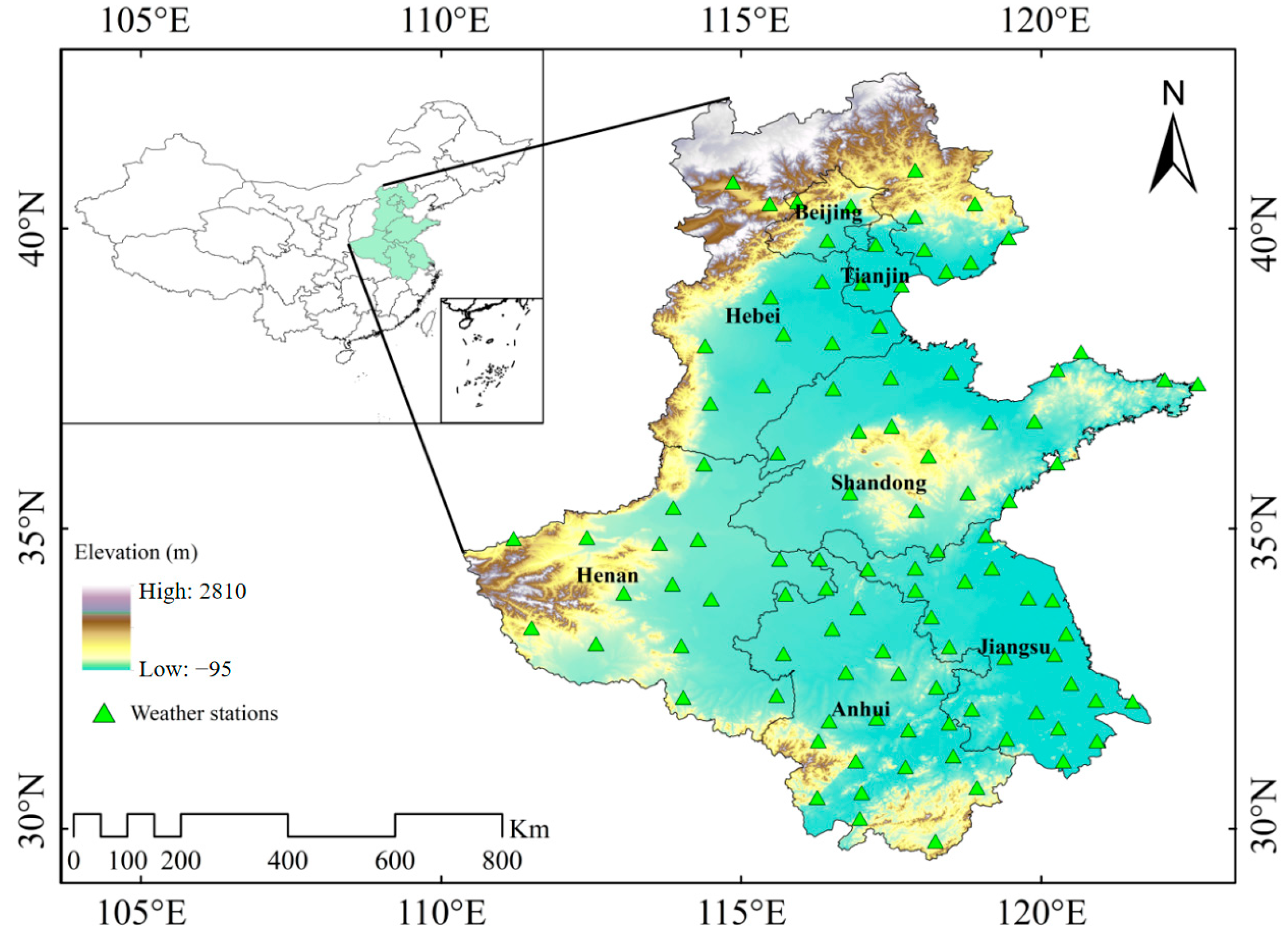
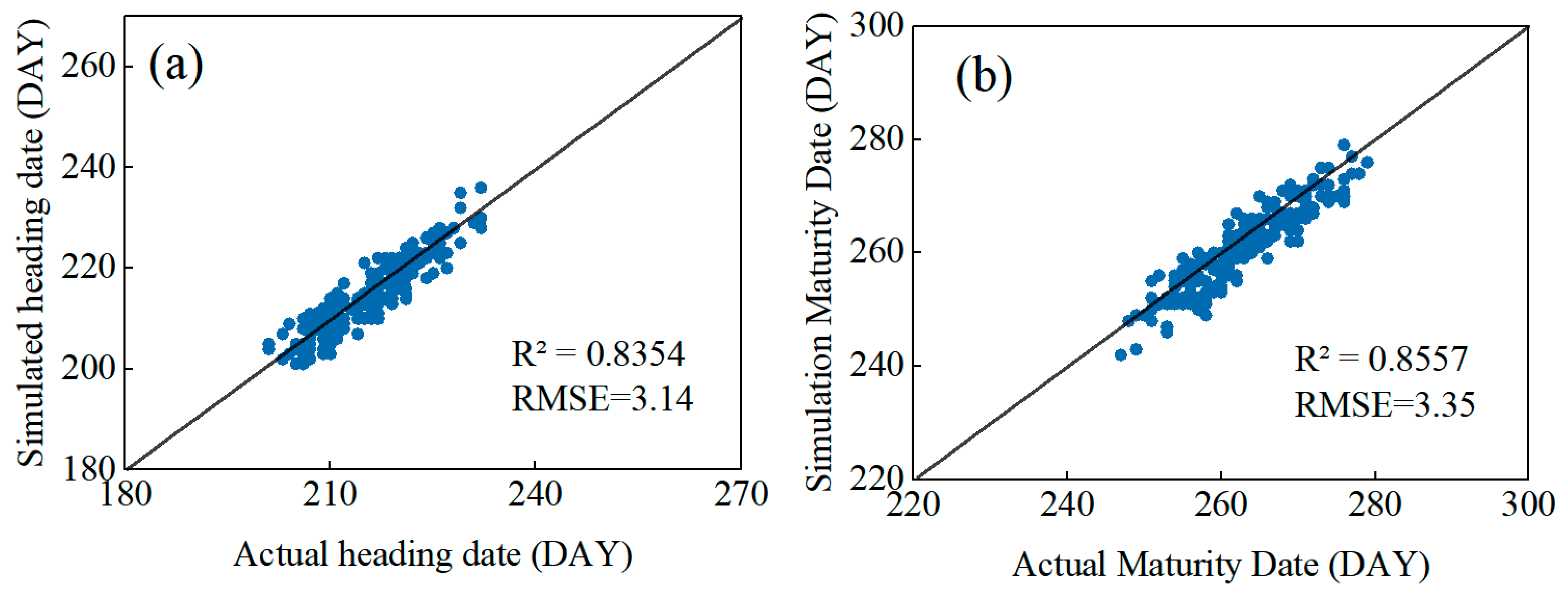
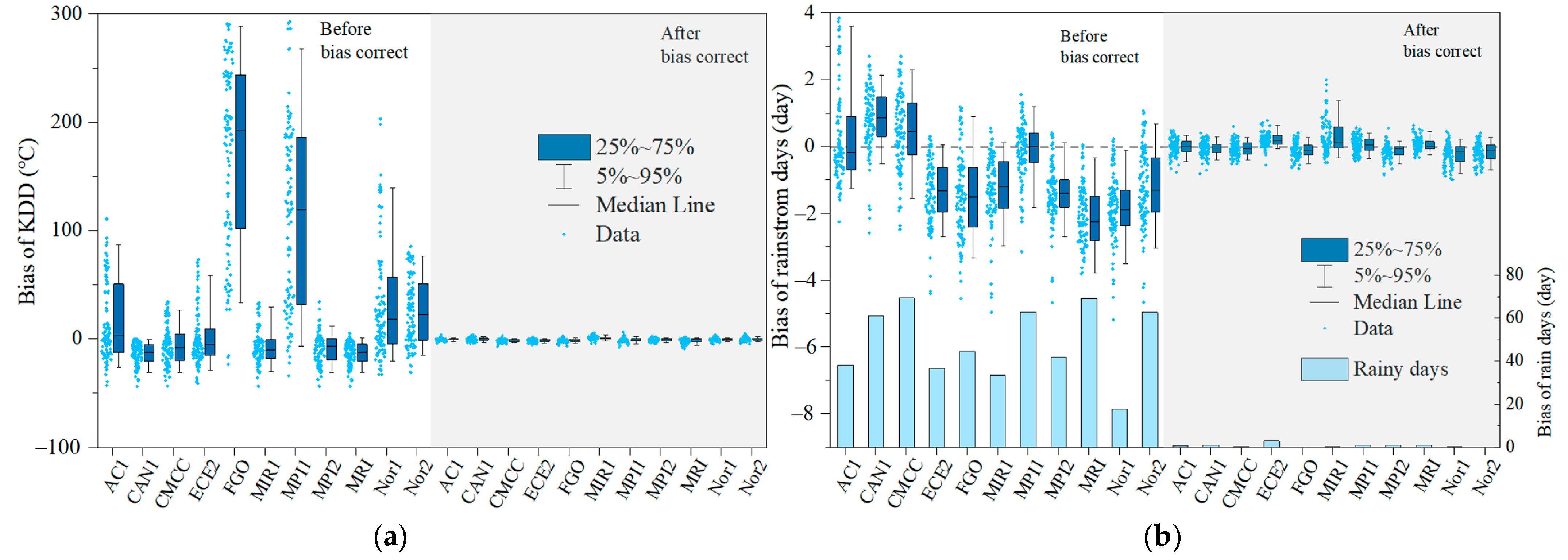
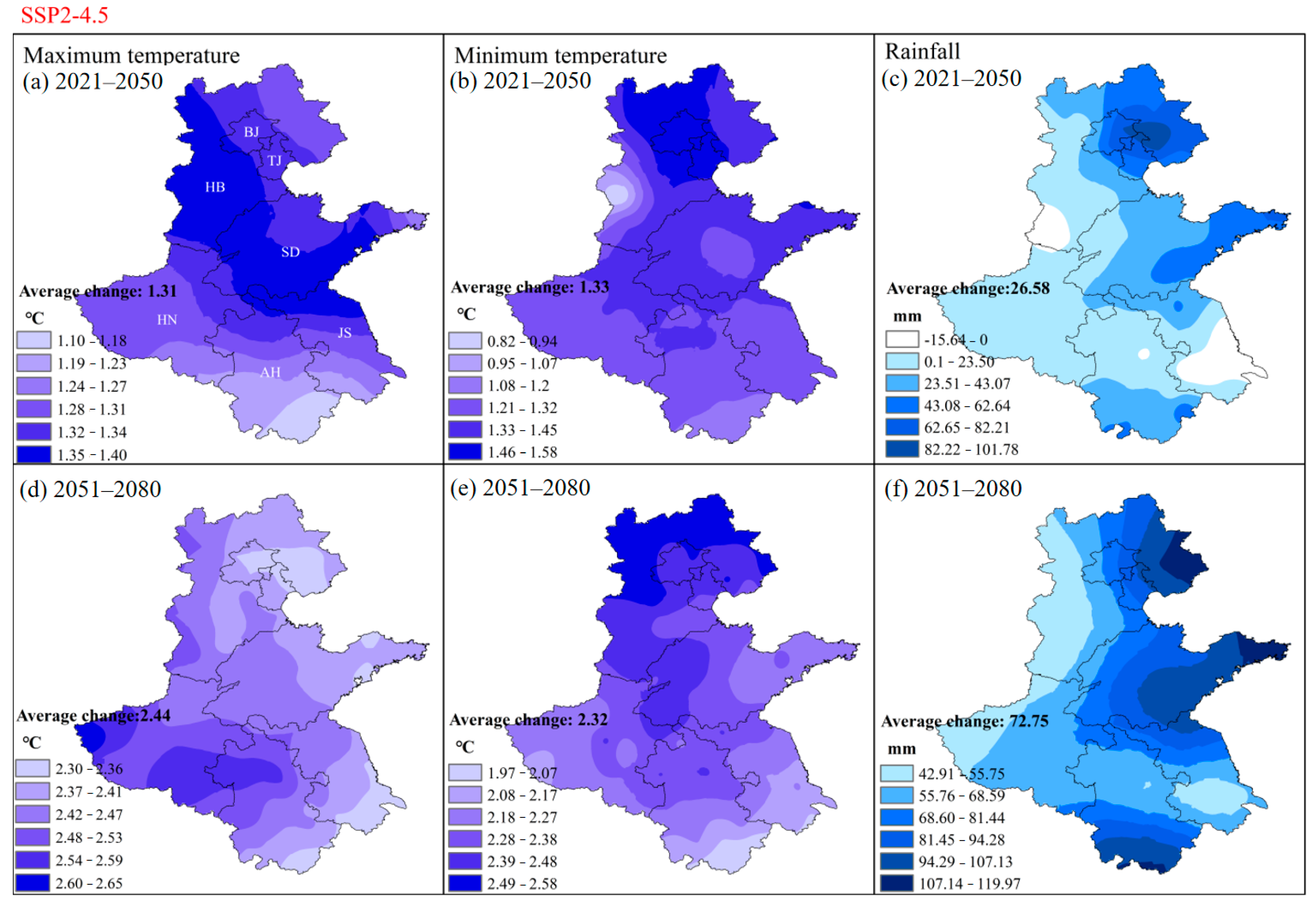




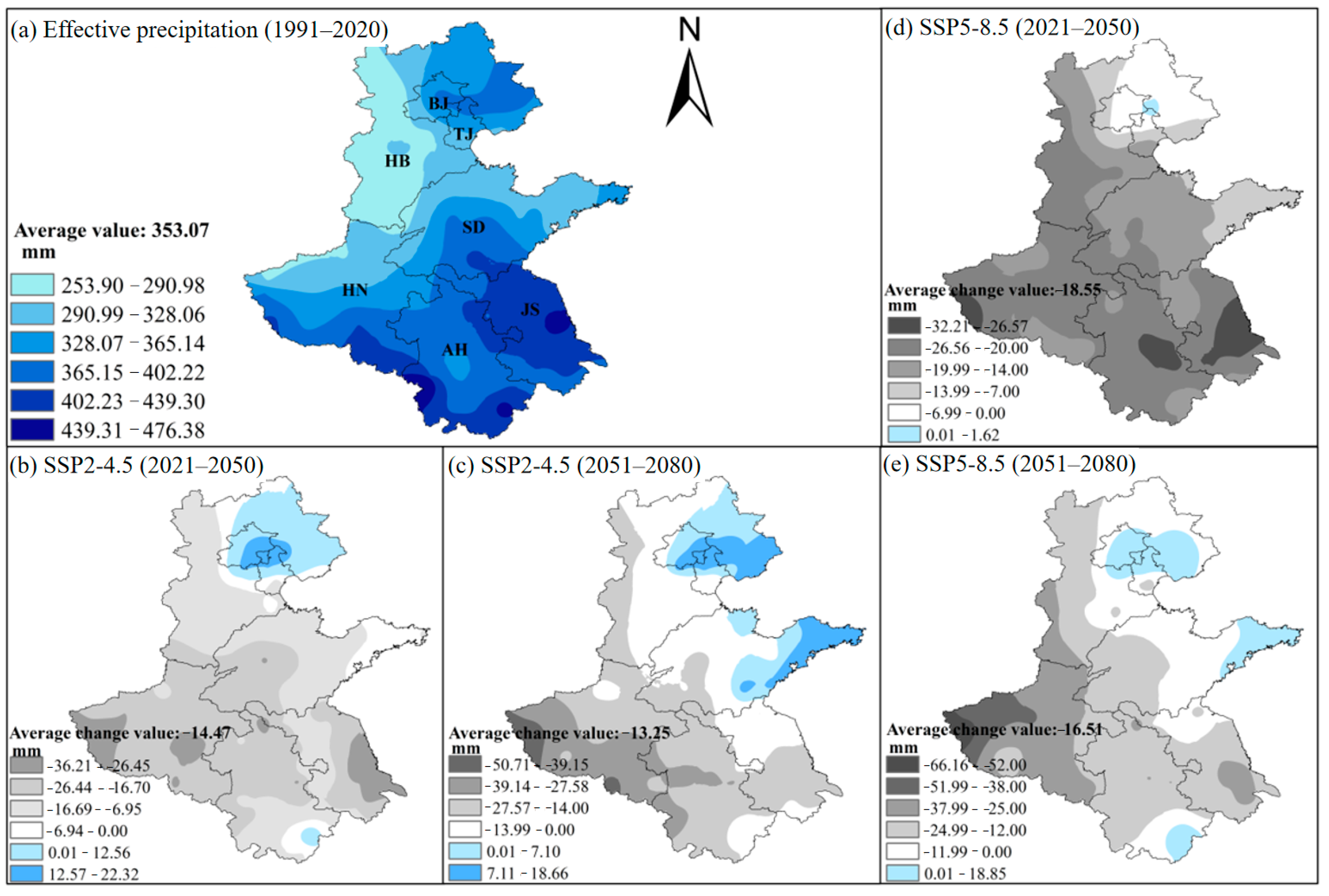


| No. | GCM Name | Abbreviation | Institution | Resolution |
|---|---|---|---|---|
| 1 | ACCESS-CM2 | AC1 | CSIRO-BOM | 1.875° × 1.25° |
| 2 | CanESM5 | CAN1 | CCCMA | 2.8° × 2.8° |
| 3 | CMCC-CM2-SR5 | CMCC | CMCC | 1.0° × 1.0° |
| 4 | EC-Earth3 | ECE2 | EC-EARTH | 1.0° × 1.0° |
| 5 | FGOALS-g3 | FGO | FGOALS | 2.5° × 2.5° |
| 6 | MIROC6 | MIR1 | MIROC | 1.4° × 1.4° |
| 7 | MPI-ESM1-2HR | MPI1 | MPI-M | 1.0° × 1.0° |
| 8 | MPI-ESM1-2LR | MPI2 | MPI-M | 2.0° × 2.0° |
| 9 | MRI-ESM2-0 | MRI | MRI | 1.0° × 1.0° |
| 10 | NorESM2-LM | Nor1 | NCC | 1.0° × 1.0° |
| 11 | NorESM2-MM | Nor2 | NCC | 1.0° × 1.0° |
| Parameters | Hebei | Tianjin | Beijing | Henan | Shandong | Jiangsu | Anhui |
|---|---|---|---|---|---|---|---|
| Planting Date (dd/mm) | 19/06 | 17/06 | 20/06 | 26/06 | 16/06 | 16/06 | 21/06 |
| Growing degree days from sowing to emergence (°C·day) | 122 | 114 | 123 | 89 | 117 | 83 | 134 |
| Growing degree days from sowing to maximum rooting (°C·day) | 961 | 978 | 959 | 1015 | 924 | 909 | 909 |
| Growing degree days from sowing to senescence (°C·day) | 1351 | 1422 | 1445 | 1481 | 1405 | 1398 | 1398 |
| Growing degree days from sowing to maturity (°C·day) | 1638 | 1734 | 1646 | 1761 | 1693 | 1851 | 1829 |
| Growing degree days from sowing to start of yield formation (°C·day) | 656 | 660 | 666 | 735 | 697 | 649 | 715 |
| Duration of flowering in growing degree days (°C·day) | 167 | 182 | 175 | 192 | 188 | 207 | 196 |
| Duration of yield formation in growing degree days (°C·day) | 585 | 596 | 628 | 641 | 632 | 686 | 657 |
| GCM | June | July | August | September | October | |||||
|---|---|---|---|---|---|---|---|---|---|---|
| P (mm) | Tx (°C) | P (mm) | Tx (°C) | P (mm) | Tx (°C) | P (mm) | Tx (°C) | P (mm) | Tx (°C) | |
| ACCESS-CM2 | 10.28 | 0.30 | 12.92 | 0.21 | 16.17 | 0.32 | 8.81 | 0.26 | 6.44 | 0.43 |
| CanESM5 | 10.34 | 0.32 | 14.11 | 0.22 | 8.34 | 0.42 | 10.53 | 0.22 | 2.17 | 0.40 |
| CMCC-CM2-SR5 | 12.15 | 0.17 | 14.08 | 0.28 | 10.50 | 0.23 | 6.99 | 0.23 | 2.42 | 0.23 |
| EC-Earth3 | 17.15 | 0.21 | 20.09 | 0.34 | 15.25 | 0.29 | 7.98 | 0.43 | 5.63 | 0.38 |
| FGOALS-g3 | 14.37 | 0.21 | 14.76 | 0.26 | 21.26 | 0.31 | 6.33 | 0.28 | 2.54 | 0.25 |
| MIROC6 | 11.94 | 0.28 | 13.47 | 0.24 | 15.54 | 0.28 | 11.13 | 0.20 | 6.26 | 0.22 |
| MPI-ESM1-2HR | 9.84 | 0.20 | 16.85 | 0.35 | 11.63 | 0.21 | 6.44 | 0.21 | 4.64 | 0.46 |
| MPI-ESM1-2LR | 8.03 | 0.26 | 13.18 | 0.18 | 14.09 | 0.39 | 8.19 | 0.28 | 4.81 | 0.27 |
| MRI-ESM2-0 | 13.90 | 0.27 | 12.63 | 0.20 | 8.80 | 0.22 | 11.20 | 0.21 | 6.63 | 0.39 |
| NorESM2-LM | 11.79 | 0.16 | 13.06 | 0.34 | 12.69 | 0.24 | 8.98 | 0.21 | 5.47 | 0.36 |
| NorESM2-MM | 9.54 | 0.20 | 16.44 | 0.25 | 18.59 | 0.19 | 7.32 | 0.30 | 1.88 | 0.30 |
| Meteorological Factors | SSP2-4.5 Scenario | SSP5-8.5 Scenario | ||||||
|---|---|---|---|---|---|---|---|---|
| 2021–2050 Year | 2051–2080 Year | 2021–2050 Year | 2051–2080 Year | |||||
| Absolute Change | Rate of Change (%) | Absolute Change | Rate of Change (%) | Absolute Change | Rate of Change (%) | Absolute Change | Rate of Change (%) | |
| Radiation/(MJ/m2/d) | 0.32 | 3.9% | 0.67 | 8.17% | 0.47 | 5.73% | 0.85 | 10.37% |
| Wind speed/(m/s) | 0.04 | 1.71% | 0.09 | 3.85% | 0.01 | 0.04% | −0.01 | −0.04% |
| Rainfall days/(day) | 2 | 2.47% | 3.31 | 4.08% | 3.44 | 4.25% | 8.97 | 11.07% |
| Moderate rain days/(day) | 1.65 | 15% | 1.65 | 15% | 0.77 | 7% | 1.49 | 13.55% |
| Rainstorm days/(day) | 0.78 | 32.5% | 0.77 | 32.08% | 0.34 | 14.17% | 0.81 | 33.75% |
Disclaimer/Publisher’s Note: The statements, opinions and data contained in all publications are solely those of the individual author(s) and contributor(s) and not of MDPI and/or the editor(s). MDPI and/or the editor(s) disclaim responsibility for any injury to people or property resulting from any ideas, methods, instructions or products referred to in the content. |
© 2024 by the authors. Licensee MDPI, Basel, Switzerland. This article is an open access article distributed under the terms and conditions of the Creative Commons Attribution (CC BY) license (https://creativecommons.org/licenses/by/4.0/).
Share and Cite
Xiang, Y.; Cheng, R.; Wang, M.; Ding, Y. Response of Matching Degree between Precipitation and Maize Water Requirement to Climate Change in China. Agronomy 2024, 14, 181. https://doi.org/10.3390/agronomy14010181
Xiang Y, Cheng R, Wang M, Ding Y. Response of Matching Degree between Precipitation and Maize Water Requirement to Climate Change in China. Agronomy. 2024; 14(1):181. https://doi.org/10.3390/agronomy14010181
Chicago/Turabian StyleXiang, Yuanyuan, Ruiyin Cheng, Mingyu Wang, and Yimin Ding. 2024. "Response of Matching Degree between Precipitation and Maize Water Requirement to Climate Change in China" Agronomy 14, no. 1: 181. https://doi.org/10.3390/agronomy14010181
APA StyleXiang, Y., Cheng, R., Wang, M., & Ding, Y. (2024). Response of Matching Degree between Precipitation and Maize Water Requirement to Climate Change in China. Agronomy, 14(1), 181. https://doi.org/10.3390/agronomy14010181





